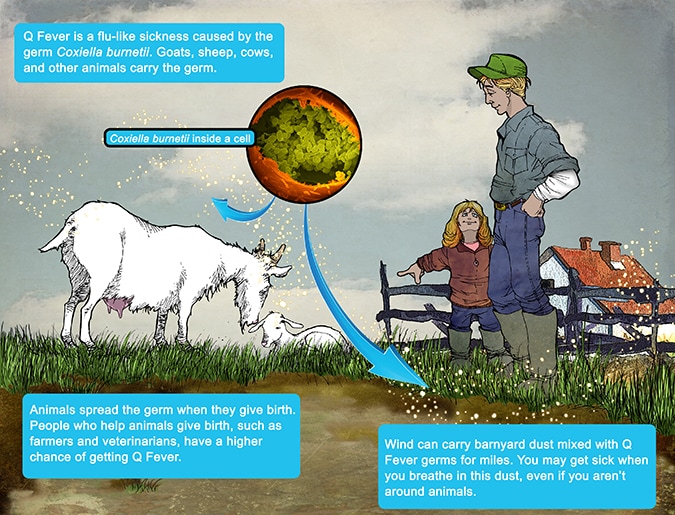Transmission
People get infected by breathing in dust that has been contaminated by infected animal feces, urine, milk, and birth products that contain Coxiella burnetii. Direct contact (e.g. touching, being licked) with an animal is not required to become sick with Q fever. People may also get sick with Q fever by eating contaminated, unpasteurized dairy products. Rarely, Q fever has been spread through blood transfusion, from a pregnant woman to her fetus, or through sex.
People at risk for Q fever infection
Certain professions are at increased risk for exposure to C. burnetii, including veterinarians, meat processing plant workers, dairy workers, livestock farmers, and researchers at facilities housing sheep and goats. People working in these areas may need to take extra precautions (see MMWR R&R: Occupational Exposure and Prevention).

Bioterrorism
- A biological attack, or bioterrorism, is the intentional release of viruses, bacteria, or other germs that can sicken or kill people, livestock, or crops.
- C. burnetii, the bacteria that causes Q fever, has been described as a potential bioterrorism agent.
- C. burnetii is a select agent subject to the select agentexternal icon regulations found in 42 CFR Part 73.
- C. burnetii is a highly infectious agent, in some cases requiring less than 10 bacteria to make you sick.
- C. burnetii is extremely resistant to heat, drying, and many common disinfectants.
- People get infected by breathing in contaminated dust.
- C. burnetii has been previously weaponized for use in biological warfare and is considered a potential terrorist threat.
- We do not know if or when a bioterrorism attack might occur. However, federal agencies have worked for years with health departments across the country to plan and prepare for any such attack.